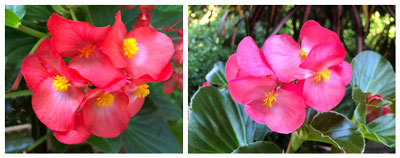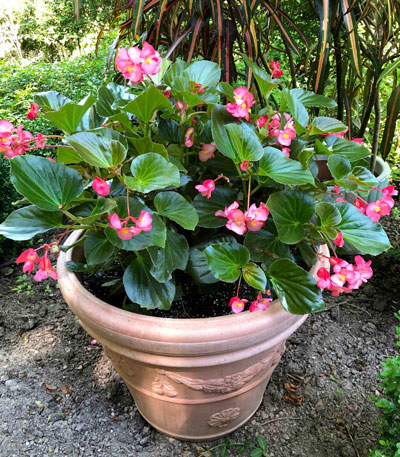They earned their name “Whopper”
I grew wax begonias from seed as an 8th grader. Folks, that deserves a round of applause. Those babies aren’t easy. The seeds are as fine as dust and the seedlings look like moss as they germinate. But I loved and nurtured those little plants, and I grew them in our family’s landscape there on the east side of the campus in College Station.
Those were small varieties of wax begonias with leaves the size of quarters and flowers not much larger than marbles.

Now we meet Goliath. These things are my little begonias on vitamins, minerals and super food all in one. H-U-G-E wax begonias called “Whoppers.” Several websites list them as “the largest wax begonias ever.” These things are big, and they’re beautiful. You may already have grown them, but they’re still fairly new in the marketplace.
One of the commercial publications I was just reading referred to growing Whopper begonias for retail sale in 1-gallon pots! That made me smile. It sounds more like what you’d say for azaleas or crape myrtles, but this is for a flowering annual.

Here are the pertinent facts about Whopper begonias…
• Grow to 18 to 30 inches tall and 15 to 18 inches wide.
• Best if planted in April or early May so plants can become established before summer. (Hang onto that info for next year.)
• Best in shade or part shade or morning sun, perhaps with protection from the hottest afternoon sun.
• Both bronze- and green-leafed varieties are sold. Bronze types are more tolerant of sun.
• Red and pink flower colors are available.
• Virtually pest-free.
• Keep moist but not wet for prolonged periods. Do not get water on leaves when sun is hitting them in summer.
• Can be sheared back and over-wintered in pots in a warm greenhouse.
I was fortunate to have visited a friend’s greenhouse growing operation a couple of months ago. He had 24 Whopper begonias left over and asked if I’d like them. “You bet!!!” was my reply, and you can see the results.
Fun fact about wax begonia seeds…
Did you know that wax begonia seeds are just about the smallest of any flowering plant that we grow? Some orchid seeds may be smaller, but wax begonia seeds are dust-like. It takes one million seeds to equal one ounce. When they germinate the little seedlings look like green moss for the first couple of weeks!
